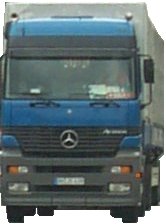|
|
Driving Preparation (truck)

Assignment
Traffic makes special demands on the sense of responsibility. This is valid, not only for the attitude while driving, but also for the tour preparation.
Visual examination
It is also one of the most important checks by the garage. Not by any means is everything supervised electronically. If it were so, then no more reserves would exist. These are needed however, on a journey of perhaps
3000 km and more. A critical look cannot do any harm.
Air pressure
The air pressure in all the wheels, including the possibly available spare tyre/s/-wheel/s, this can protect you from nasty surprises. Even if it turns out that everything is in order, the driver gets a feeling for the changes
and thus, for the best check-up intervals. Almost more important is the check for damage, in particular, in inaccessible places. Of course, the tread-depth also plays a role.
Oil level
Even a really good engine uses oil. In fact, if absolutely no oil has been used, as a driver, one should begin to have suspicions. Since under normal conditions, e.g., the cylinder sleeves must be lubricated. There
should still be an oil film for the pistons moving after TDC. Oil scraper rings should not simply 'scrape' everything off. This is already prevented by a certain roughness of the sleeve-surfaces (cross-grinding pattern by
honing).
Therefore, the oil level should be checked regularly, either by using the dip-stick, or by electronic analysis, and this particularly with new engines or replacement engines.
Coolant
Fortunately, in modern vehicles, the coolant must no longer be refilled. Should this however, be the case, there is definitely something defective. Nevertheless, the checking is very important because the results of
insufficient coolant are significant for the internal combustion engine.
Belt drives
The results of damaged belt drives can also be serious, because the belt drive is often a part of the cooling system. If e.g., only the generator is affected, one still has time to pay a visit to a workshop. Nevertheless, the
belt drives should be checked for, tears, ageing (cracking) and tension.
Current consumers
The most important current consumers should of course, be checked for functionality. Even though modern trucks have, e.g., at the rear, double lighting units, the complete breakdown of one side is still possible.
Cold starting
In general it is still valid, that the number of cold starts, decisively influences the service life of the internal combustion engine. Unfortunately, the petrol engine, through oil thinning and a lack of lubricant film, even more
than the diesel engine. However, also here the sulfuric acid formed from fuel residue and other particles caused by an incomplete combustion, leave traces on the piston walls, the cylinder sleeves and also in the oil.
Therefore, the quick achievement of the operating temperature is important. This "warm-up" period increases with the engine idling and is thus, also responsible for high pollutant emission.
Therefore, it is
recommended, that the vehicle be driven at mid-range RPMs to warm-up the engine. With heating systems, whose effect is controlled through the coolant flow, switching off the heating can even help. By the way, the full
performance demand should not be dependant on the coolant temperature but only when the oil temperature has reached approx. 80°C.
Running-in
Due to the greatly extended service intervals and through the falling away of first inspections, one gets the impression, that the running-in of new components is no longer necessary. Of course there are, e.g., for
engines and other subassemblies, running-in programs from the manufacturers. Also, the results of not running-in will not be noticed directly. However, it is still necessary not to demand the full efficiency from new- or
exchange components or new component groups immediately. This is even valid, e.g., for new brake linings, which will not only give a higher service life, but, above all, a better operating performance.
Compressed air brakes
While the previous points apply to nearly all vehicles, the compressed air brake concerns trucks only. Because the brakes depend on outside force and thus, on compressed air, they and the air suspension should be,
particularly in winter, kept free of condensation. This leads to the lack of brake-release, corrosion and particularly when the water freezes, to sensitive malfunctions. Brake assemblies with air dryers and/or automatic
drainage valves need only monitoring.By the way, the construction of the compressed air brake makes special demands on the sense of responsibility of the driver. One should not drive off with less than 5.5 bar
pressure in the service brake. Fortunately, the spring reservoirs prevent driving with substantially lower pressure.
Driving-time regulations
Ever since 2007, there is a new EU ordinance for the protection from fatigue for truck and coach drivers in which the steering- and resting times are regulated. A 24 hour break is compulsory after 56 hours per week (6
working days) behind the wheel. Per day (24 hours), a nine-hour break must be taken. If this regulation is not adhered to, not only the driver, but also, e.g., the transport manager and/or their superior authority can be
held responsible. 10/09
|
|